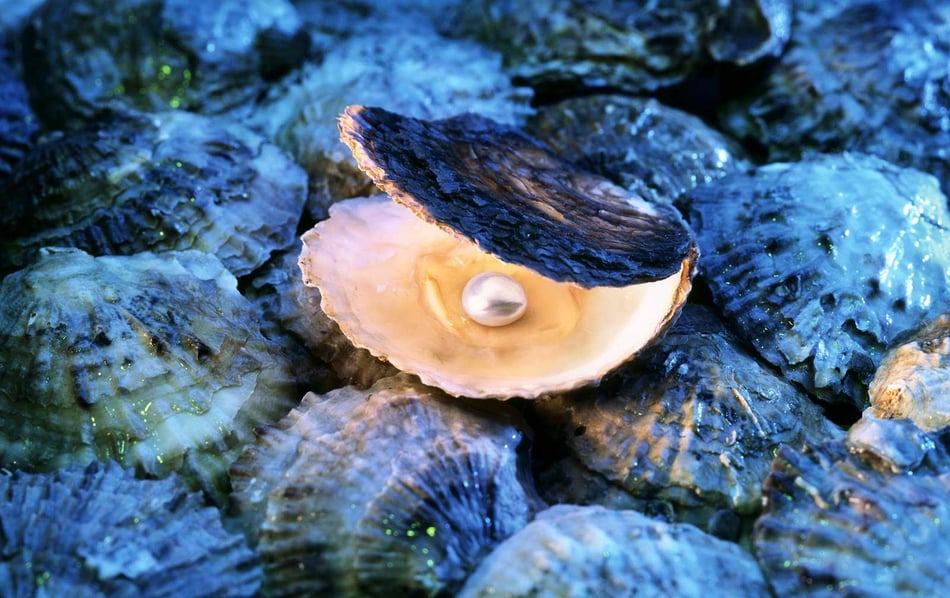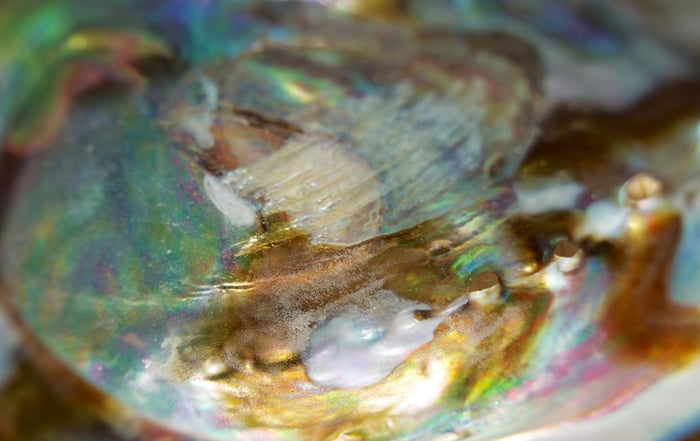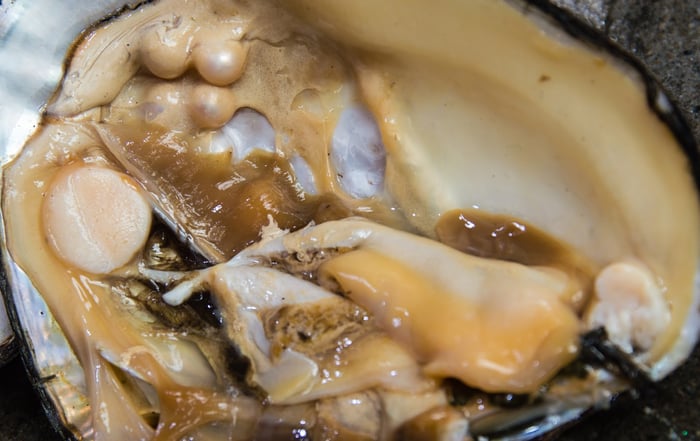From Grain to Glamour: The Oyster's Pearl-Making Process

Tin
3
min. read

Pearls have long captivated humanity with their delicate luster and understated elegance. These natural jewels, however, are not just products of beauty but also results of an intricate interaction of biology and time within the humble oyster.
By delving into the pearl-making process, we not only unravel a marine marvel but also gain insights crucial for marine conservation.
Oysters and the Birth of a Pearl: An Oceanic Marvel
Oysters, often celebrated for their culinary delights, hold a much deeper significance in marine ecosystems. As filter feeders, they play a pivotal role in cleaning the water, thereby promoting clearer waters and encouraging the growth of underwater plants, essential for a thriving marine life. But beyond this ecological role, oysters possess a mesmerizing ability to transform tiny irritants into gleaming treasures: pearls.
Imagine a fine grain of sand, or perhaps a minuscule parasite, inadvertently finding its way inside an oyster's shell. To the oyster, this foreign object is discomforting. Then, the oyster’s defense mechanism kicks in.

It begins to secrete a smooth, crystalline substance called nacre, which is the same material that forms its inner shell. Over time, it will coat the substance with this until it forms a pearl. The very essence of the pearl lies in its formation process—each shimmering layer tells a story of patience and resilience.
The birth of a pearl is a testament to nature's ability to turn adversity into beauty.
The birth of a pearl is a testament to nature's ability to turn adversity into beauty.
The Evolution of a Pearl: From Intruder to Gem
At the heart of every pearl lies an unexpected guest—a grain of sand, a fragment of shell, or a minuscule invader.
Once the foreign object establishes itself within the oyster, the mollusk sets to work, diligently coating the irritant with layer upon shimmering layer of nacre. This fluid, produced by the oyster's mantle tissue, envelops the invader, and over time, crystallizes into what we recognize as the lustrous surface of a pearl.
However, the formation of a pearl isn't an overnight job. Depending on the species, environmental conditions, and the size of the irritant, the creation of a pearl can take anywhere from a few months to several years. Factors like water temperature, salinity, and the oyster's diet all play roles in determining the pearl's final size, shape, and even its hue. While the pearls formed spontaneously by the oyster’s natural mechanisms are termed "natural pearls," a majority of pearls in the market today are "cultured."

Cultured pearls arise from a process where humans intentionally introduce an irritant into oysters under controlled conditions, ensuring a more predictable size, shape, and yield. Both types of pearls hold their unique allure, but their stories are different. One speaks of nature's natural response, while the other of human ingenuity working with nature's craft.
Harvesting and Conservation
As gemstones that exude timeless beauty, pearls have an enduring global demand. While this demand brings economic opportunities, it also carries with it the responsibility to manage our marine resources conscientiously.
Happily, many pearl producers are rising to the challenge through sustainable farming practices, which not only produce quality pearls but also contribute positively to marine conservation.
Sustainable pearl farming practices often focus on the health and well-being of the oyster, recognizing that a healthy oyster is more likely to produce a quality pearl.
Moreover, these practices often utilize integrated multi-trophic aquaculture, where the oysters are farmed alongside other species in a mutually beneficial arrangement. This diversification enhances water quality and creates a richer, more balanced marine ecosystem.
Of course, the role of oysters extends beyond the enchanting pearls they produce. As natural water purifiers, they filter pollutants and provide habitats for a multitude of marine species. A flourishing oyster bed is often an indicator of a healthy marine ecosystem, rich in biodiversity.
As admirers and consumers of pearls, our choices can champion a cycle of sustainability and beauty. By supporting sustainable pearl farming practices, we not only adorn ourselves with nature's treasures but also contribute to the well-being of our seas.
The Oyster's Lesson: Turning Challenges into Treasures
The creation of each pearl is nothing short of miraculous - but as impressive as pearls are, it's the health of the marine ecosystems, including the essential water-filtering role of oysters, that underscores their true significance.
As consumers and stewards of our planet, it's our responsibility to support and champion sustainable pearl harvesting.

Just as these remarkable creatures transform an irritant into a pearl of great value through patience and resilience, IMARCS harnesses the potential of the ocean to restore marine ecosystems and fortify coastal communities. Our commitment to pioneering innovative mariculture solutions resonates with the oyster's transformative journey, reflecting a profound belief in the power of nature and science working together.
References:
Awaji, M., Yamamoto, T., Iwahashi, Y., Nagai, K., Hattori, F., Maeyama, K., Kakinuma, M., Kinoshita, S., & Watabe, S. (2018). Pearl production by implantation of outer epithelial cells isolated from the mantle of Pinctada fucata and the effects of blending of epithelial cells with different genetic backgrounds on pearl quality. In Biomineralization (pp. 359–366). Springer Singapore.
Eisenstadt, A. (2021, August 5). The true story behind how pearls are made. Smithsonian Magazine. https://www.smithsonianmag.com/blogs/national-museum-of-natural-history/2021/08/05/true-story-behind-how-pearls-are-made/